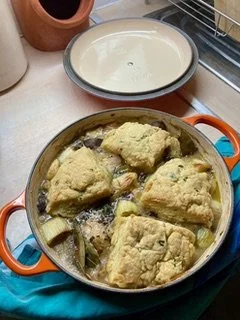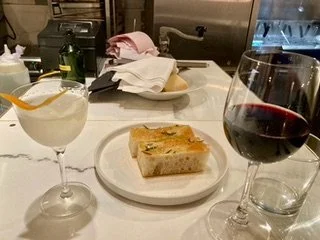Plus ça change, plus c'est la même chose
Photo © Rob Jones
So, I was doing a bit of research into Medieval Welsh cuisine, as you do.
I stumbled across a chap called Gerald of Wales, or Giraldus Cambrensis, as he was known to his friends. He was half-and-half, much like myself, of mixed Welsh and Norman ancestry and as such he was an ideal person to travel through Wales and write a case study on the people and how to subjugate them, which he did in his Descriptio Kambriae which dates from around 1190.
This wasn’t a particularly pleasant time to live in Wales. There was a lot of in-fighting between the various Welsh princes and lords, and also the increasingly assertive bully-boy Normans. Henry II, William the Conqueror’s great grandson was on the throne and singularly failed to subdue the Welsh due, he claimed, to bad weather. As far as I’m concerned, that’s right up there with ‘the dog ate my homework.’ That pleasure lay ahead for Edward Longshanks, Edward I, who really loved building castles.
This in part explains why an earlier trip through Wales by Gerald in 1188, with the then Archbishop of Canterbury, Baldwin, was a bit of a tough gig. At the time, he was trying to recruit volunteers for the third crusade. Not everyone signed up.
Anyway … I digress.
Apart from noting that Welsh cuisine was a bit plain, mainly composed as it was of meat and dairy, un-spiced at that, Gerald actually had quite a lot to say about the eating habits, and habits generally, of the Welsh. Some of it was not particularly flattering.
He noted that the Welsh were a bit extreme – there’s nothing worse than a bad Welshman, but likewise no one nicer than a good one. They lied. They cheated, They Stole. And they spoke about you behind your back.
However, no one begs. Their homes are open to all, which oddly is also still true today. Gerald was really flummoxed by the habit Welsh people had of striding into each other’s homes as if they owned the place. Even today, don’t be surprised if in some parts of Wales friends and neighbours barge into your kitchen or parlour without knocking. Just make sure they check their weapons in at the door.
The Welsh, Gerald said, always welcomed people into their homes and truly genuinely expected you to stay. However, if you refused water to wash your feet, then that was a clear sign you’re not stopping, and planed to hack on to your next destination. But while you’re here, have a beer!
Guests were treated to some harp playing until it became clear that you’re sticking around for dinner, then it was all hands on deck to cobble something together from what’s available. Guests ate first, and if there wasn’t enough to go round then the hosts would happily go hungry till the next day.
In Gerald’s time, people tended not to eat until the evening. During the day they had things to do, people to see, places to go, battles to fight. Dinner was modest. Dishes were few. Nothing highly seasoned. There’s no ceremony, tablecloths, or napkins. They sat in threes, and food was served on platters and shared.
Unleavened bread was baked daily – not unlike the Greek Lagana bread you find today - to dip into broth with occasionally some chopped meat hurled into the mix.
One eye was always kept on the door, in case marauders burst in unexpectedly.
So, it’s not a promising start, though it sets the tone. Welsh food has always been practical, tasty, basic and wholesome. Obviously, there were regional variations, Wales after all is a country of contrasts. We ate and still eat whatever is available on the plains, the hills, by the sea, in the towns. Most people were quite poor, so some of the luxuries which came along with the Normans - fancy herbs, spices, and for some reason Cod - simply didn’t filter down to the ordinary people at that time, but stayed firmly locked up in the castles.
And after dinner… people flopped where they were, not bothering to change into night attire. Let’s draw a veil over their washing habits. I’ll leave all that to your imagination.
Now, since you’re here, and you’ve washed your feet, why not have some…
Cabbage Broth with Ham
The key to this dish is to use the water you boil the ham in, to make the broth. Ideally you should boil gammon for about an hour and half to release all the salt. Remember to keep topping up the water so it doesn’t boil dry. Remove the joint, and then roast and dice the meat.
Boil up some potatoes (though clearly this is a later ingredient from the New World) and dice them while still firm.
Finely chop some onions and leeks and sauté them in butter. Add a little flour to make a roux and add the ham water gradually. (Sadly Garlic didn’t become common in the British Isles till the mid-16th century, but add some if you wish.)
Rough chop some cabbage and add it along with the potato and bring to a simmer until you get a thick broth.
Before serving, pour in a little single cream. Season with some pepper BUT not salt as there’s plenty in the Ham water.
Sprinkle the boiled and/or roast ham across the top of the broth.
Serve with bread to dip in the broth and clean the bowl afterwards.
This is equally good with mutton, chicken and rabbit, and you can also add in other vegetables you have lying around such as cauliflower, carrot or parsnip, but not too much because the broth should remain creamy white.
Fell free to fall asleep afterwards, fully clothed. Let yourself out in the morning.
I have to say this broth is fabulous, waiting as I am for the full force of storm Isha to hit this weekend. Hatches are battened down. The larder is full. I’m going NOWHERE.
R




